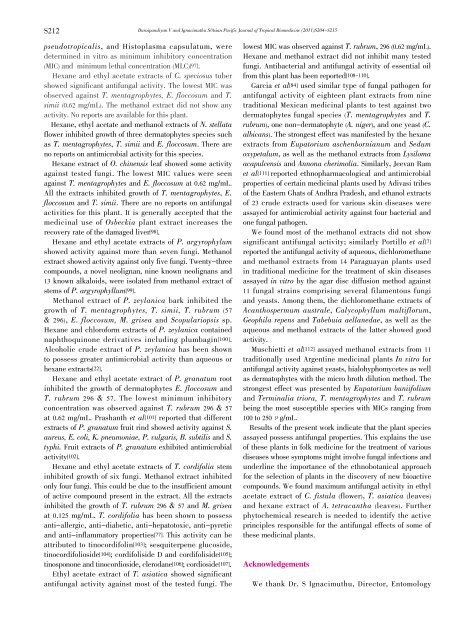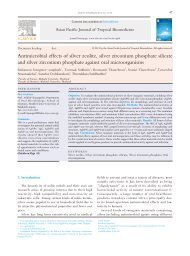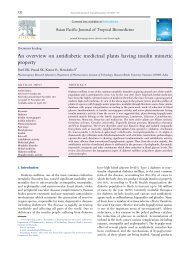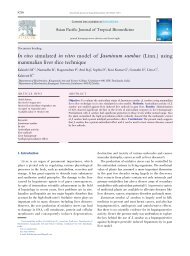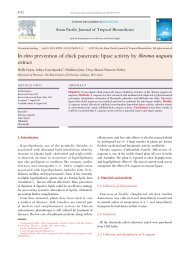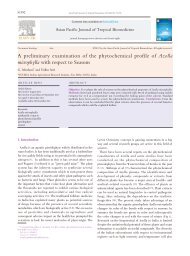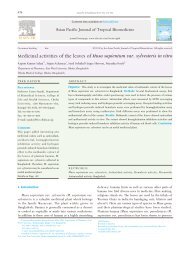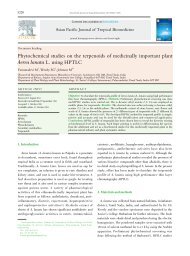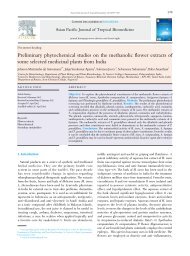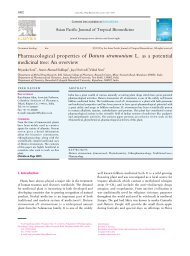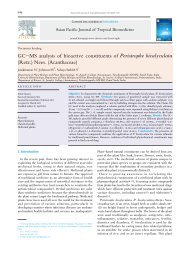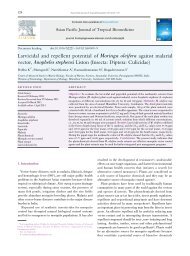Antifungal activity of traditional medicinal plants from Tamil - Apjtb.com
Antifungal activity of traditional medicinal plants from Tamil - Apjtb.com
Antifungal activity of traditional medicinal plants from Tamil - Apjtb.com
Create successful ePaper yourself
Turn your PDF publications into a flip-book with our unique Google optimized e-Paper software.
S212<br />
Duraipandiyan V and Ignacimuthu S/Asian Pacific Journal <strong>of</strong> Tropical Biomedicine (2011)S204-S215<br />
pseudotropicalis, and Histoplasma capsulatum, were<br />
determined in vitro as minimum inhibitory concentration<br />
(MIC) and minimum lethal concentration (MLC)[97].<br />
Hexane and ethyl acetate extracts <strong>of</strong> C. speciosus tuber<br />
showed significant antifungal <strong>activity</strong>. The lowest MIC was<br />
observed against T. mentagrophytes, E. floccosum and T.<br />
simii (0.62 mg/mL). The methanol extract did not show any<br />
<strong>activity</strong>. No reports are available for this plant.<br />
Hexane, ethyl acetate and methanol extracts <strong>of</strong> N. stellata<br />
flower inhibited growth <strong>of</strong> three dermatophytes species such<br />
as T. mentagrophytes, T. simii and E. floccosum. There are<br />
no reports on antimicrobial <strong>activity</strong> for this species.<br />
Hexane extract <strong>of</strong> O. chinensis leaf showed some <strong>activity</strong><br />
against tested fungi. The lowest MIC values were seen<br />
against T. mentagrophytes and E. floccosum at 0.62 mg/mL.<br />
All the extracts inhibited growth <strong>of</strong> T. mentagrophytes, E.<br />
floccosum and T. simii. There are no reports on antifungal<br />
activities for this plant. It is generally accepted that the<br />
<strong>medicinal</strong> use <strong>of</strong> Osbeckia plant extract increases the<br />
recovery rate <strong>of</strong> the damaged liver[98].<br />
Hexane and ethyl acetate extracts <strong>of</strong> P. argyrophylum<br />
showed <strong>activity</strong> against more than seven fungi. Methanol<br />
extract showed <strong>activity</strong> against only five fungi. Twenty-three<br />
<strong>com</strong>pounds, a novel neolignan, nine known neolignans and<br />
13 known alkaloids, were isolated <strong>from</strong> methanol extract <strong>of</strong><br />
stems <strong>of</strong> P. argyrophyllum[99].<br />
Methanol extract <strong>of</strong> P. zeylanica bark inhibited the<br />
growth <strong>of</strong> T. mentagrophytes, T. simii, T. rubrum (57<br />
& 296), E. floccosum, M. grisea and Scopulariopsis sp.<br />
Hexane and chlor<strong>of</strong>orm extracts <strong>of</strong> P. zeylanica contained<br />
naphthoquinone derivatives including plumbagin[100].<br />
Alcoholic crude extract <strong>of</strong> P. zeylanica has been shown<br />
to possess greater antimicrobial <strong>activity</strong> than aqueous or<br />
hexane extracts[22].<br />
Hexane and ethyl acetate extract <strong>of</strong> P. granatum root<br />
inhibited the growth <strong>of</strong> dermatophytes E. floccosum and<br />
T. rubrum 296 & 57. The lowest minimum inhibitory<br />
concentration was observed against T. rubrum 296 & 57<br />
at 0.62 mg/mL. Prashanth et al[101] reported that different<br />
extracts <strong>of</strong> P. granatum fruit rind showed <strong>activity</strong> against S.<br />
aureus, E. coli, K. pneumoniae, P. vulgaris, B. subtilis and S.<br />
typhi. Fruit extracts <strong>of</strong> P. granatum exhibited antimicrobial<br />
<strong>activity</strong>[102].<br />
Hexane and ethyl acetate extracts <strong>of</strong> T. cordifolia stem<br />
inhibited growth <strong>of</strong> six fungi. Methanol extract inhibited<br />
only four fungi. This could be due to the insufficient amount<br />
<strong>of</strong> active <strong>com</strong>pound present in the extract. All the extracts<br />
inhibited the growth <strong>of</strong> T. rubrum 296 & 57 and M. grisea<br />
at 0.125 mg/mL. T. cordifolia has been shown to possess<br />
anti-allergic, anti-diabetic, anti-hepatotoxic, anti-pyretic<br />
and anti-inflammatory properties[77]. This <strong>activity</strong> can be<br />
attributed to tinocordifolin[103]; sesquiterpene glucoside,<br />
tinocordifolioside[104]; cordifoliside D and cordifoliside[105];<br />
tinosponone and tinocordioside, clerodane[106]; cordioside[107].<br />
Ethyl acetate extract <strong>of</strong> T. asiatica showed significant<br />
antifungal <strong>activity</strong> against most <strong>of</strong> the tested fungi. The<br />
lowest MIC was observed against T. rubrum, 296 (0.62 mg/mL).<br />
Hexane and methanol extract did not inhibit many tested<br />
fungi. Antibacterial and antifungal <strong>activity</strong> <strong>of</strong> essential oil<br />
<strong>from</strong> this plant has been reported[108-110].<br />
Garcia et al[84] used similar type <strong>of</strong> fungal pathogen for<br />
antifungal <strong>activity</strong> <strong>of</strong> eighteen plant extracts <strong>from</strong> nine<br />
<strong>traditional</strong> Mexican <strong>medicinal</strong> <strong>plants</strong> to test against two<br />
dermatophytes fungal species (T. mentagrophytes and T.<br />
rubrum), one non-dermatophyte (A. niger), and one yeast (C.<br />
albicans). The strongest effect was manifested by the hexane<br />
extracts <strong>from</strong> Eupatorium aschenbornianum and Sedum<br />
oxypetalum, as well as the methanol extracts <strong>from</strong> Lysiloma<br />
acapulcensis and Annona cherimolia. Similarly, Jeevan Ram<br />
et al[111] reported ethnopharmacological and antimicrobial<br />
properties <strong>of</strong> certain <strong>medicinal</strong> <strong>plants</strong> used by Adivasi tribes<br />
<strong>of</strong> the Eastern Ghats <strong>of</strong> Andhra Pradesh, and ethanol extracts<br />
<strong>of</strong> 23 crude extracts used for various skin diseases were<br />
assayed for antimicrobial <strong>activity</strong> against four bacterial and<br />
one fungal pathogen.<br />
We found most <strong>of</strong> the methanol extracts did not show<br />
significant antifungal <strong>activity</strong>; similarly Portillo et al[7]<br />
reported the antifungal <strong>activity</strong> <strong>of</strong> aqueous, dichloromethane<br />
and methanol extracts <strong>from</strong> 14 Paraguayan <strong>plants</strong> used<br />
in <strong>traditional</strong> medicine for the treatment <strong>of</strong> skin diseases<br />
assayed in vitro by the agar disc diffusion method against<br />
11 fungal strains <strong>com</strong>prising several filamentous fungi<br />
and yeasts. Among them, the dichloromethane extracts <strong>of</strong><br />
Acanthospermum australe, Calycophyllum multiflorum,<br />
Geophila repens and Tabebuia aellanedae, as well as the<br />
aqueous and methanol extracts <strong>of</strong> the latter showed good<br />
<strong>activity</strong>.<br />
Muschietti et al[112] assayed methanol extracts <strong>from</strong> 11<br />
<strong>traditional</strong>ly used Argentine <strong>medicinal</strong> <strong>plants</strong> In vitro for<br />
antifungal <strong>activity</strong> against yeasts, hialohyphomycetes as well<br />
as dermatophytes with the micro broth dilution method. The<br />
strongest effect was presented by Eupatorium buniifolium<br />
and Terminalia triora, T. mentagrophytes and T. rubrum<br />
being the most susceptible species with MICs ranging <strong>from</strong><br />
100 to 250 毺g/mL.<br />
Results <strong>of</strong> the present work indicate that the plant species<br />
assayed possess antifungal properties. This explains the use<br />
<strong>of</strong> these <strong>plants</strong> in folk medicine for the treatment <strong>of</strong> various<br />
diseases whose symptoms might involve fungal infections and<br />
underline the importance <strong>of</strong> the ethnobotanical approach<br />
for the selection <strong>of</strong> <strong>plants</strong> in the discovery <strong>of</strong> new bioactive<br />
<strong>com</strong>pounds. We found maximum antifungal <strong>activity</strong> in ethyl<br />
acetate extract <strong>of</strong> C. fistula (flower), T. asiatica (leaves)<br />
and hexane extract <strong>of</strong> A. tetracantha (leaves). Further<br />
phytochemical research is needed to identify the active<br />
principles responsible for the antifungal effects <strong>of</strong> some <strong>of</strong><br />
these <strong>medicinal</strong> <strong>plants</strong>.<br />
Acknowledgements<br />
We thank Dr. S Ignacimuthu, Director, Entomology


